
China Trains
Being an important mode of long-distance transportation in China, as we all know, China has the largest and fastest railway network in the world. China trains are the best way to travel long distances with reasonable speed and comfort. China Train Guide will offer you a comprehensive knowledge about China trains such as how to buy a ticket, how to read a ticket, how to board the train, etc.
China Train Types
China trains are identified by their class of service (usually indicated by letter prefix for faster trains) followed by three to four numerals indicating the bureau and region of operation. Trains starting with G, C and D are operated by CRH EMUs, forming a high-speed/high-speed train network in China, while other trains are normal trains for locomotive traction. China trains are divided into: High-speed EMU (G), Intercity High-speed (C), EMU (D), Direct Express Passenger Train (Z), Express Passenger Train (T), Express Passenger Train (K), Ordinary Passenger Train (Four-digit Digital Train), Tourist Train (Y), Temporary Passenger Train (L), and Commuter Train.
High Speed Trains in China
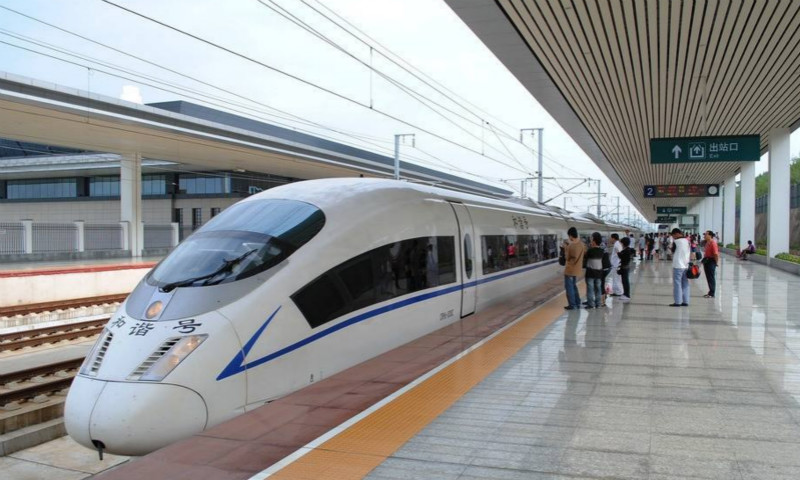
- G Trains: The fastest trains among all the high speed trains in China. Long distance high-speed service with a speed of 250-400km/h. G-series trains take less time to reach their final destination because they stop at fewer stations on the route.
- C Trains: Intercity service. They usually travel at speeds below 200 km/h. By May 2018, more than 260 railway stations had passed by train C.
- D Trains: Long distance service with EMU. Maximum speed 200–250 km/h (120–160 mph). Only D-series operate overnight high speed trains in China.
Normal Trains in China
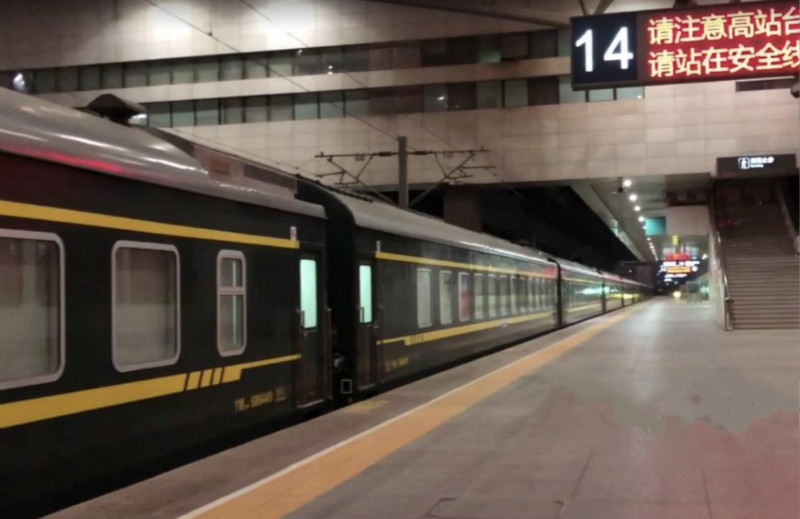
- Z Trains: Direct express service between two cities, with few or no stops; often overnight trains. The highest speed is 160 kilometers (99 miles) per hour.
- T Trains: Long distance service stopping only at provincial capitals, subprovincial-level and major prefecture-level cities. Maximum speed 140 km/h (87 mph).
- K Trains: Service stopping at prefectural and higher-level cities. Maximum speed 120 km/h (75 mph).
Seats for China Trains
Seat of China’s High Speed Trains
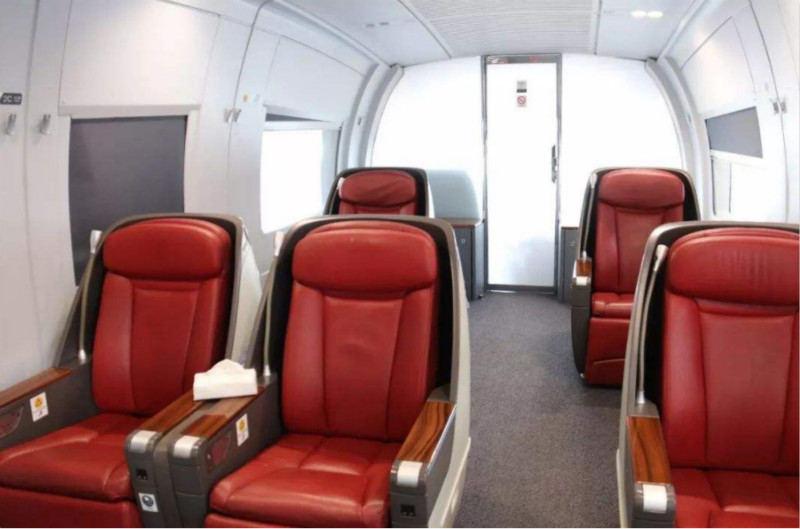
- Premium Class Seat: Not available for every High Speed Train. Some seats are like that of business class, some like that of 1st class.
- Business Class Seat: Have fully-reclining leather chairs, reading lamp, service call, large tray table, back cushions, etc. It is the most advance and deluxe among all types of seats.
- 1st Class Seat: Two seats on either side of a center aisle, with more plentiful leg room. It is equipped with tray table, footrest, windowsill, pillow, power sockets, etc.
- 2nd Class Seat: A tighter seating arrangement with three seats on one side of the aisle and two on the other.
- Sleeper: Three types of sleeper including New Individual Sleepers, Soft Sleepers Compartment, Deluxe Soft Sleeper Compartment.
Seat of China’s Normal Trains
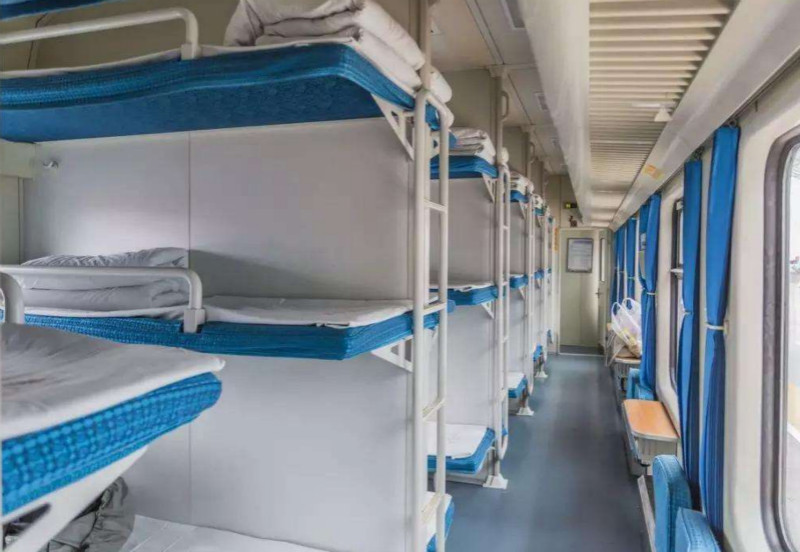
- Hard Seat: Hard bench seats set at a 90 degree angle with a table in between.
- Soft Seat: Like the seat of airplane’s economic class.
- Hard Sleeper: Have berths of six beds – three on each side – with a small table between and no door.
- Soft Sleeper: Have berths of four beds – two on each side – with a small table between and a door.
How to Book Train Tickets in China
Whether you book online or at the railway station, you need a passport. At present, you can only book Chinese train tickets 30 days in advance. You can book on the official website of China Railway or some online travel agencies, or go to any railway station in China to buy tickets.
Buy China Train Tickets Online
There are three main ways to book online: 12306 Website, trip.com, or travel agency.
- 12306 Website: The official website of China Railway (www.12306.cn) is the most authoritative website and the best way for you to buy train tickets on the computer. Here you can check the correct real-time train schedule, ticket prices, remaining tickets, train policy, latest news, and booking train tickets. Unfortunately, this is not easy. In addition to the website is all in Chinese, it also needs a Chinese telephone number and a Chinese bank account.
- trip.com: You can also book tickets on some Chinese travel website like trip.com, with an extra booking fee.
Buy China Train Tickets at Railway Stations
You can go to any nearby railway station to book tickets in the ticket hall. The original passport and cash are required. The ticket hall of a railway station is usually located on the side of the entrance to the main station. Ticket vending machines operate on certain routes but never accept foreign passports as identity cards. If the train station is too far away from you, you can also try to find a small ticket office on some of the main streets of a big city. A commission fee of 5 yuan is required without the same kind of queues. These booking offices are open only between 9 a.m. and 6 p.m.
Buy China Train Tickets through Travel Agency
Almost all the travel agencies in China provides the train tickets service and China Dragon Tours also offer this kind of service. We can deliver your tickets directly to your hotel which is very practical and convenient. Our professional travel consultants with excellent English will help you book, changing, and cancel the tickets. All consultation, including seat selection, will be handled by experienced consultants to ensure that you get the best service.
See How to Book China Train Tickets.
How to Collect China Train Tickets
If you buy the ticket online, you need to collect the paper ticket before you board the train. You can collect ticket at the ticket counters in any railway station in China. When collecting the tickets, you need to show your original passport. If you want to skip the hassle at the train station, you can also pick up your tickets at the official train ticket office, with a commission fee of 5 RMB.
If you book the tickets from Ctrip, you can choose the ticket delivery service to save time. While if you book the ticket from us, we can deliver your tickets directly to your hotel or let our tour guide collect it for you.
See How to Collect China Train Tickets.
How to Read the Ticket

According to the number in the picture above, we will take you to read the ticket.
- 1: Departure Station, written both in Chinese and English.
- 2: Train Number. It tells you the type of the train and the the number of the train.
- 3: Arrival Station, written both in Chinese and English.
- 4: Departure Time and Date, written as year/month/day/time.
- 5: Seat Assignment. The number of train car is followed by seat number. Below shows the seat.
- 6. ID Information: It shows the first few digits of your passport or Chinese ID and your last name or Chinese full name.
See How to Read Your Train Tickets.
How to Take a Train
Step 1: Get to the Right Station
The first one, of course, is that you need to get to the right station. As the development of China railway, there are usually several railway stations in a city. So make sure you get to the right one. You need to check the information on the ticket, including the railway station, date and departure time, and arrive at the station at least 0.5-1 hours in advance for safety check and queuing up for boarding.
Normally, the station will named after its location, such as Beijingnan Station which printed on your ticket. “nan” refers to south, “bei” means north, “dong” refers to east and “xi” means west.
Special Note: If you book the ticket online, you can collect your ticket when you arrive at the station. Prepare some time to collect the ticket.
Step 2: Show your Ticket
When you enter the main station, the first thing you have to queue up is the ticket check. You need to show your ticket and passport to the staff to ensure that your identity matches on both.
Step 3: Go Through the Security Check
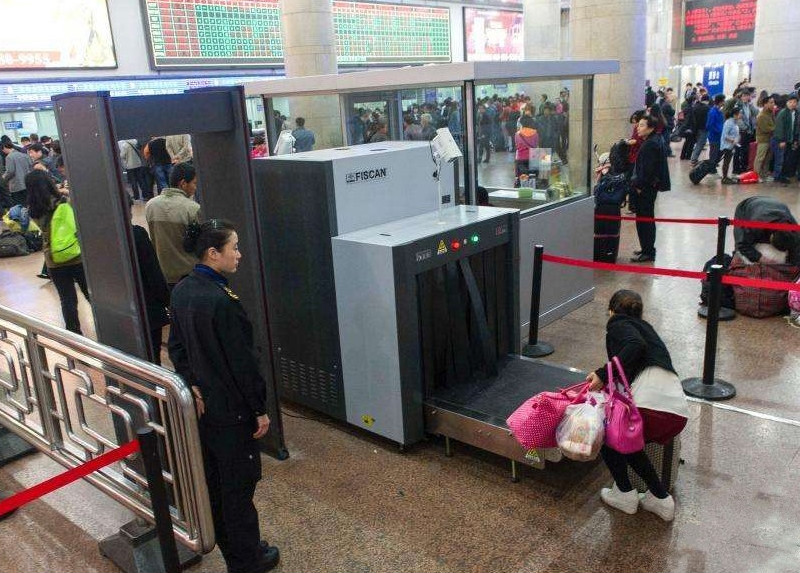
The security check at the station is something like that at the airport. You need to line up and put all your luggage on the security scanner conveyor belt. After that, walk through a metal detector door, stand still, and have the staff scan you to see if you are carrying prohibited items. Take care of your luggage.
Step 4: Find your Waiting Room
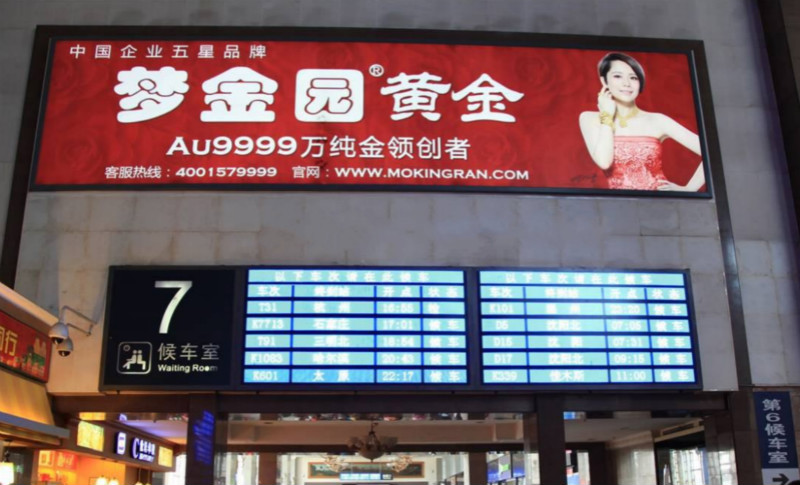
At the waiting hall, there is a LED screen showing the waiting room of each train. According to the information, you can find your waiting room and wait for boarding. Below is an example of the information on the LED screen.
| Chinese | 车次 | 终到站 | 发车时间 | 候车室 | 状态 |
| English | Train No. | Arrival Station | Departure Time | Waitng Room | Status |
| e.g. | G2890 | Chengdudong | 13:22 | G3, G4 | Wating |
Step 5: Check in
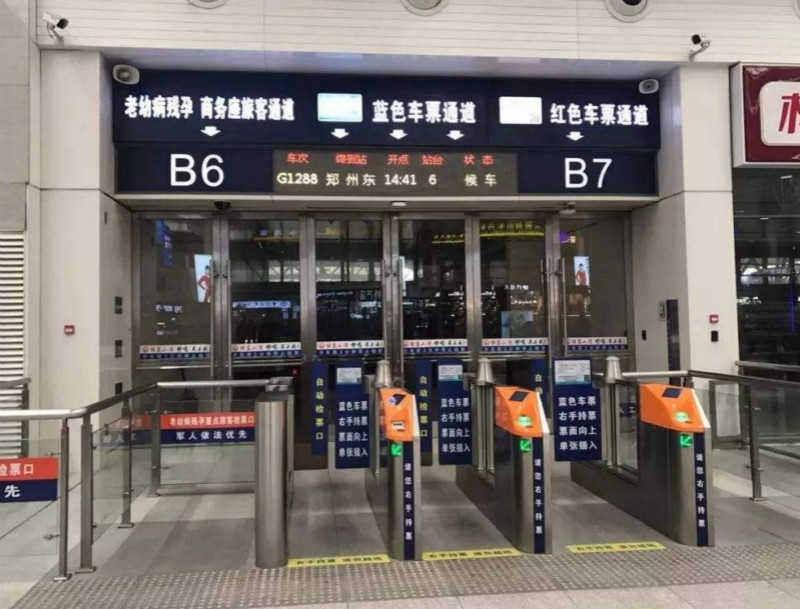
At your waiting room, there is a LED screen where you can check whether you will get on board at this gate. Fifteen to twenty minutes before the train leaves, the door opens and the conductor will check your ticket for the last time as you walk to the platform. Barriers close 5 minutes before departure. Your red ticket could be checked by the staff and your blue ticket could be auto-checked.
Step 6: Find Your Train and Seat
After check in, follow the people and find your train. When you get on the train, show your ticket to the staff to make sure you get on the right train. Find your carriage and your seat according to the information on your ticket. After that, Enjoy the Ride! Keep your ticket and you will need to show your ticket again at the exit of the station.
When you’re on the train…
How to Handle your luggage
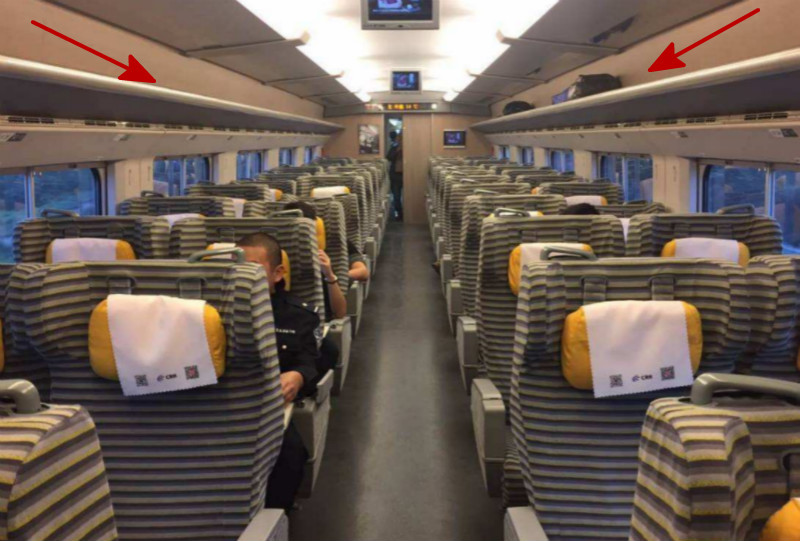
According to China Railway Safety Management Regulations, passengers who have purchased tickets can carry a certain amount of luggage free of charge on Chinese trains. Each adult passenger can carry 20 kilograms (44 pounds) of luggage. Every child with a ticket can carry less than 10 kilograms (22 pounds) of luggage. For normal trains, the sum of length, width and height of each piece of luggage shall not exceed 160 cm (63 inches). The length of the rod-shaped luggage should not exceed 200 cn (79 inches). For high-speed trains, the total of the three dimensions cannot exceed 130 cm (51 in) and a rod-shaped item cannot exceed 130 cm (51 in).
After boarding, find the rack and put the luggage on. If you take the high-speed rail, here are luggage racks over the seats at either side of a carriage and luggage or smaller luggage can be placed on the rack above the seat. You can also put the large suite in the luggage compartment at the junction of the two carriages, or in the empty room behind the last row of seats in the carriage. Generally speaking, first class, business class and soft sleeper compartments have more space to store luggage than second class compartments. If you take an ordinary train, you can only put your luggage on the rack above or below the seat.
See China Train Baggage Allowance & Policy.
What to Drink and Eat on the Train

No matter you take the normal train or high-speed train, foods, drinks and snacks are provided on the train. While all the food are Chinese local food which may not satisfy your stomach. When it’s time for meals, the attendants will push a trolley to sell food or drinks. Passengers can also move to the dining car to buy the meals.
If you’re not used to Chinese food, you can eat before or after your short journey. While if you’ll take a long trip, you’d better pack some food before getting on the train.
See Food & Drinks on China High Speed Trains.
Bathrooms on the Train
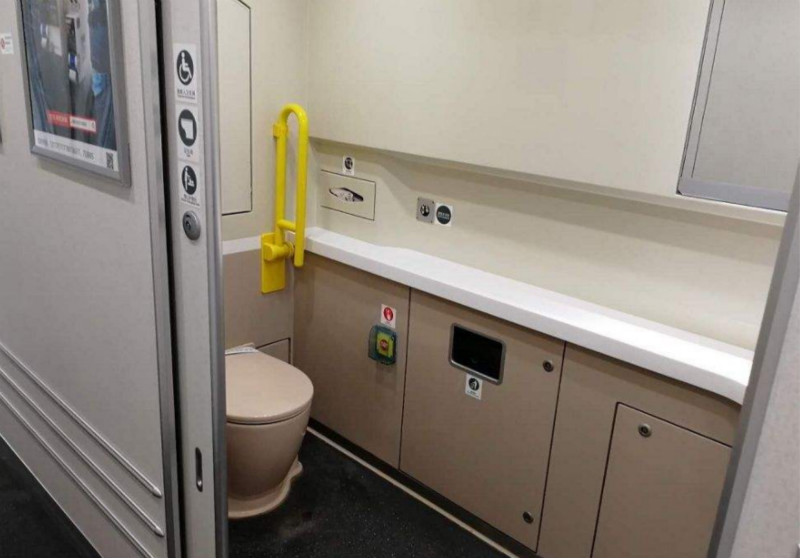
Toilets on high-speed trains are usually modern and clean. Waiters often clean toilets. There is toilet paper in the bathroom. Smoking is not allowed in the toilet. You can check the signs on the door of the bathroom. The red sign on the door means that the toilet is occupied, and the green sign means that no one means it is not occupied.
Barrier-free toilets are available on most high-speed trains in China, which are designed for disabled passengers. There is a small stage in the toilet where mothers can change diapers for babies. There is a sigh in Chinese and English on all the large automatic doors of the toilet. The bathroom has a large space with a Western-style bathroom, a large basin, an armrest and a mirror. Toilet paper is provided.
See Toilets & Washrooms on China High Speed Trains.
Arriving at the Destination and Get off the Train
Pay attention to the announcement of arrival. Most of the announcements on normal trains are in Chinese. Some high-speed trains have bilingual announcements. If you need to get off at the intermediate station, you’d better remember your arrival time. You can also ask the conductor or other passengers to remind you.
Follow the people or signs at the station (usually only in China), you will get the right exit. You may need to carry your luggage to get to the exit through the long stairs. Your ticket will be inspected again at the exit gate. If you need to change to another train at the same station, you don’t need to get out of the station and re-enter. Follow the signs and the LED information, and you can find the waiting room for the transfer train directly.
At present, most of the railway stations are connected to the urban by metro. You can easily take the metro from the station to the city center. Some railway stations even have an area inside the station for passengers to take taxis to their destinations.
Popular China Train Routes
In China, train is an important mode of long-distance travel. China’s high-speed railway network is by far the longest and the most comfortable HSR in the world. Convenient railway network in China boosts train travel greatly. Traveler who like different landscapes must try to travel by train in China, because you will surprise by the drawing on the windows of the train. See below popular China train routes or contact our consultant to tailor-make your amazing China train tours!
8 Days Beijing-Xian-Shanghai Tour by Speed Train
11 Days Tibet Mount Everest Tour from Shanghai by Train
12 Days Sichuan-Tibet Train Tour
13 Days Qinghai and Tibet Train Tour from Beijing
25 Days South China Minorities Discovery by Speed Train
Keep Reading










